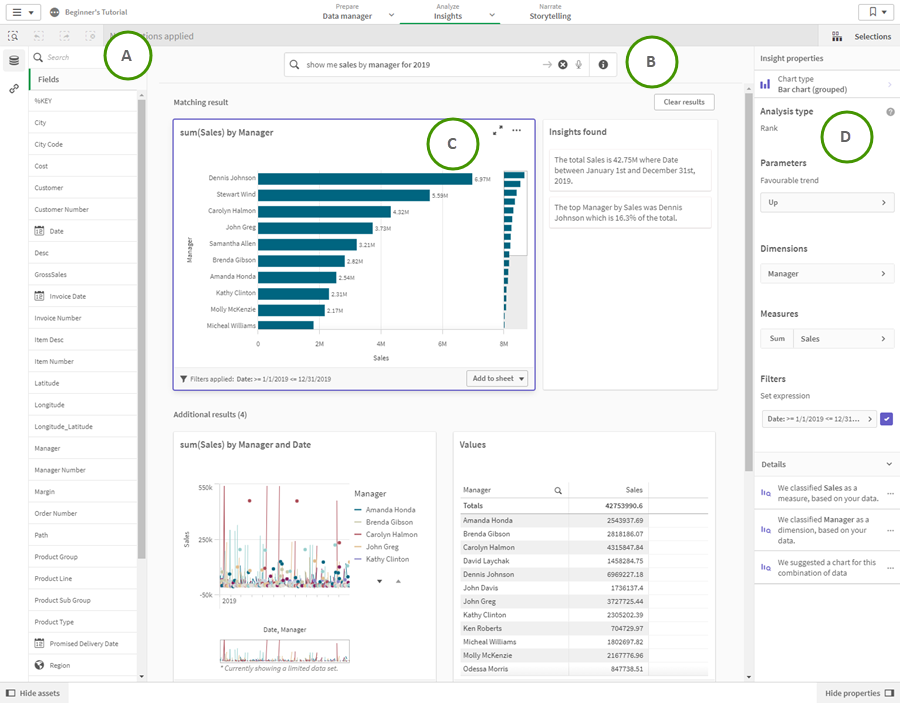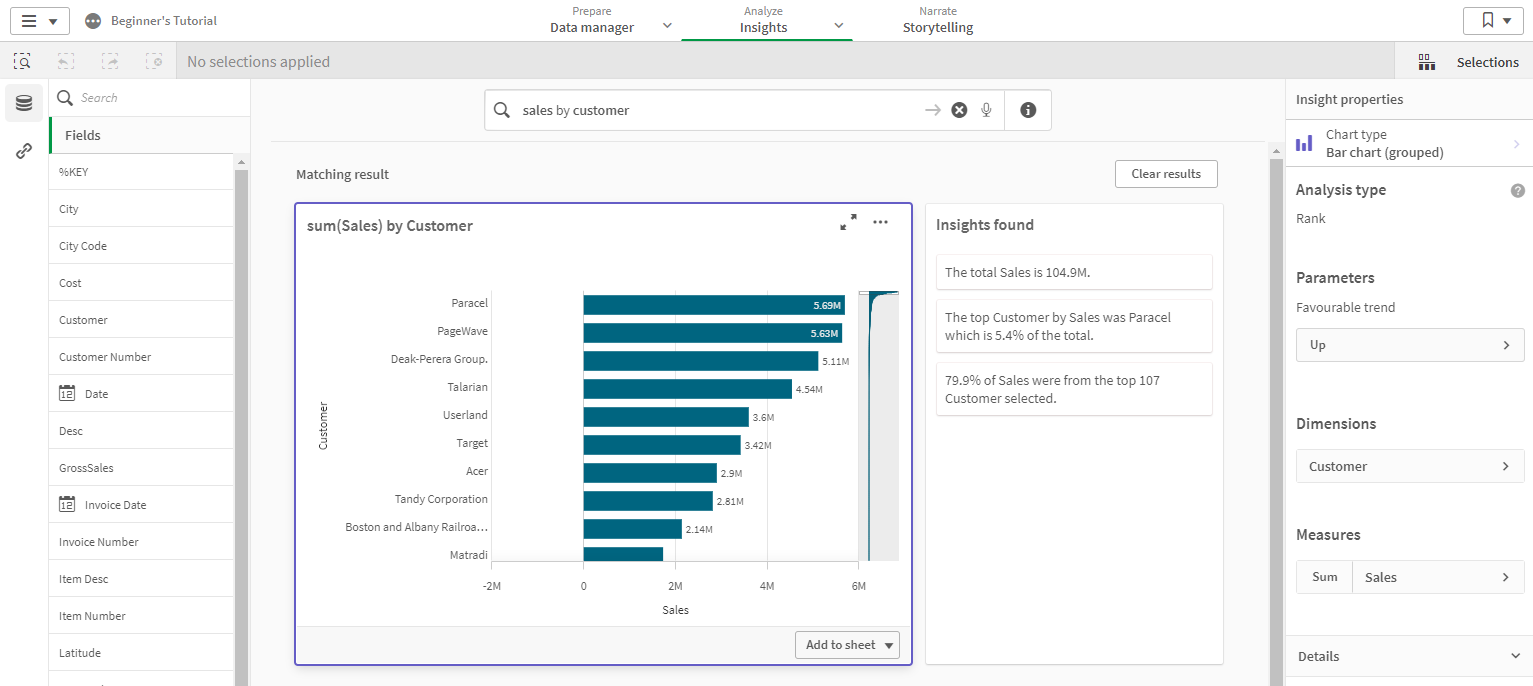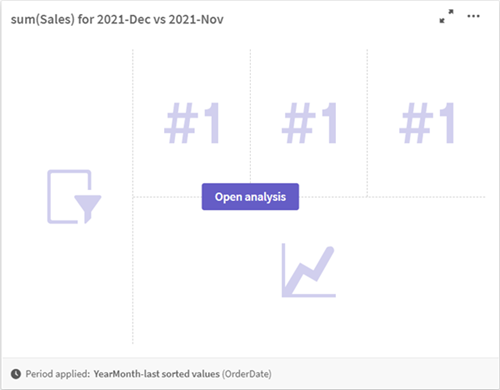Creating visualizations with Insight Advisor
Insight Advisor provides search-based analysis for exploring your data and creating visualizations. Insight Advisor uses the Qlik cognitive engine to create visualizations based on app fields and master items.
Insight Advisor search-based analysis is available from Insights in the Analyze tab. You can also open Insight Advisor when you load data into your app.
You can search Insight Advisor to display visualizations. Insight Advisor creates new Insights charts and displays existing visualizations from your sheets. Insight Advisor can also generate visualizations from your data set without a search query. Insight Advisor can analyze your app data and create charts of potential interest.
Insight Advisor relies on the Qlik cognitive engine and a logical model of your data to create visualizations. The logical model contains the relationships and uses of fields in your data model. By default, Insight Advisor builds a logical model by learning from user interactions with Insight charts. If users add charts to sheets or edit charts, Insight Advisor learns these preferences.
You can also create your own custom logical model for the app. Business logic lets you to define the relationship and use of data in your logical model. When business logic is turned on, precedent-based learning is not available. If you define calendar periods and set them as default periods, period analysis and period performance analysis types are available. For more information, see Customizing logical models for Insight Advisor.
Users can access Insight Advisor in the hub with Insight Advisor Chat. For more information, see Exploring apps with conversational analytics.
Navigating Insight Advisor
Insights contains options for creating and editing visualizations. Insight Advisor supports keyboard navigation. For more information, see Keyboard navigation and shortcuts in Qlik Sense.
Insight Advisor search-based analysis in an app.

A: Fields and master items
Insights charts are built using fields and master items
. You can select these assets to create a search query.
If the app is published, only master items are available.
B: Insights search field
You can enter your search query here, either by entering asset names or using natural language. If you used a natural language query, you can click to view the filters generated from your query.
C: Insights charts
These are the Insights charts created by Insight Advisor. Insight Advisor indicates the number of results and breaks them down into:
-
How many results are found.
-
How many charts already exist in your sheets.
-
How many charts are newly generated by Insight Advisor.
Insights charts can be added to existing or new sheets. An Insights chart can also be downloaded as an image, PDF, or as an Excel spreadsheet containing the data used in that chart.
D: Properties panel
The properties panel contains options for editing Insights charts and changing the precedents you have set in Insight Advisor.
In General properties, you can view and edit your charts and the precedents you have set for generating insights. For more information, see Managing precedents in General properties.
In Insight properties, you can edit an Insights chart and view details. You can see the Analysis type used to create the chart. Click to learn more about the analysis type used. For more information, see Editing Insights charts in Insight properties.
Searching with Insight Advisor
When you enter your search query, Qlik Sense generates relevant Insights charts using field names, field values, and master items. You can query Insight Advisor in three ways:
-
Entering a natural language query, such as Show me Product by Revenue in Sweden.
Information noteQlik Sense supports English natural language queries.
If your Qlik Sense deployment includes access to a Qlik Sense SaaS tenant, administrators can enable additional support for Spanish, French, Portuguese, and Russian. English is used by default for browsers not set to a supported language. The language used for queries can be changed by selecting a new language from the Language button. For more information, see Enabling multi-language natural language queries in Qlik Sense Enterprise on Windows.
For guidelines on using natural language in your searches, see Using natural language with Insight Advisor.
- Choosing fields and master items to use in the query, either by entering their name or selecting them.
-
If your browser's voice-to-text capability is supported in Insight Advisor, you can click the microphone icon to ask Insight Advisor your query.
Information noteInsight Advisor supports Google Chrome voice-to-text capabilities for asking queries. Qlik Sense Desktop does not support voice-to-text capabilities for queries.
Google Chrome voice-to-text capabilities are not supported with iOS devices.
Insight Advisor uses the fields or terms you specify. It may use additional fields in the generated visualizations. Insight Advisor uses any precedents you have given it for hiding charts, setting fields as dimensions or measures, or excluding fields from analysis. In Qlik Sense Enterprise, Insight Advisor can use precedents learned from other published apps if they use a similar or identical data model.
For natural language queries, Insight Advisor tries to find a matching Insight chart result. If one is found, it shows related results as well. If no matching results can be found, Insight Advisor shows possibly related results. You can click to view how Insight Advisor generated results from your search query.
Matching result with narrative insights

If you receive the following error message: "Unable to generate insights - Please try again later," you might not meet the CPU requirements for Insight Advisor.
Check the System requirements for Qlik Sense Enterprise and contact your Qlik administrator.
Using Insights charts
You can expand a Insights chart by selecting it or clicking . You can then make selections in it. Selections apply to all Insights charts. Selections made in charts from your sheets are kept when you open Insights. Selections do not affect the charts created by Insight Advisor. For more information on exploring visualization and making selections, see Discover.
If an Insights chart is new, you can add it to your sheets. If the chart exists in a sheet, you can click the sheet name at the bottom of the chart to go to that sheet.
Some analysis types, such as period over period dashboard, provide multiple related visualizations rather than a single chart. These show a preview of the kind of visualizations included in the analysis. Click Open analysis to view the analysis with data.
A period over period dashboard analysis

You can view additional options by clicking . The following options are available:
- Full screen: Expand a chart to make selection.
-
Edit insight properties: Edit the Insights chart to change dimension, measures, and the chart type.
- Add to sheet...: Add the chart to a new or existing sheet.
- Add to new sheet: Add the charts to a new sheet (period analysis, period performance against target, period over period, period over period dashboard analysis types only).
-
Download: Download the insights chart as an image, PDF, or data.
-
Hide: Hide charts that you do not want Insight Advisor to use again. You can view the charts hidden from your current search query in General properties.
Information noteHide is not available in apps using business logic.
Editing Insights charts in Insight properties
You can edit Insights charts by selecting an Insights chart and clicking . The following properties are available in Insight properties:
- Chart type: Select a different chart type. For an outline of the alternate chart types available for the different analyses, see Insight Advisor analysis types.
-
Favorable trend: (Rank analysis only) Indicate if the favorable trend for ranking is to increase or decrease.
-
Dimensions and Measures: Change the fields used as Dimensions or as Measures. You can change the measure aggregation. You can reorder measures or dimensions by dragging them
Dimensions and measures from Insights charts can be added to your master items. Click a dimension or measure and click Add new.
If you specified filters in a natural language query, such as specific field values, you can modify them as well.
-
Details: View information about why the chart was generated and the precedents Insight Advisor has learned from a chart. By selecting details, you can change or reject them. You can set fields as dimensions or measures or exclude fields from future analysis. You can hide charts from future analysis by selecting We suggested a chart for this combination of data and clicking Hide this chart.
-
Analysis period: Change which period from business logic calendar periods is applied to the chart.
Selecting an analysis period for rank type charts allows you to also view period and period performance analysis types.
Information noteAnalysis period is only available when business logic is turned on and calendar periods have been created for the app.
Editing calendar period Insights charts
If a default calendar period is assigned to a group, additional period analysis types are available as Insights charts. These have different properties than standard Insights charts. The following types are available:
-
Period changes: Shows the change of a measure from the current or latest period in the selected analysis period.
-
Period performance against target: Compares a change in a measure from the current period to the previous period. The change is measured using a forecasted target value. You define the percentages for meeting the target, almost meeting the target, and missing the target.
-
Period over period: Compares a change in a measure of the current period versus the previous period.
-
Period over period dashboard: Compares changes in a measure over time between periods. It includes a filter pane for exploring dimension values period over period.
These analysis types have unique properties. Period changes and Period over period dashboard have the following properties:
-
Breakdown: Select the dimension to use with the measure to view the period changes.
-
Measures: Select the measure for which you want to see period changes.
-
Analysis period: Select the analysis period. You can adjust the analysis period by selecting new values from Period 1 or Period 2.
Period performance against target has the following properties:
-
Parameters: Set the limits for percentage limits expected change margin and expected change rate.
-
Favorable trend: Indicate if the favorable trend for the measure is to increase or decrease.
-
Breakdown: Select the dimension to view the detailed period changes with the measure.
-
Measures: Select the measure for which you want to see period changes.
-
Analysis period: Select the analysis period. You can adjust the analysis period by selecting new values from Period 1 or Period 2.
Period over period has the following properties:
-
Measures: Select the measure for which you want to see period changes.
-
Analysis period: Select the analysis period. You can adjust the analysis period by selecting new values from Period 1 or Period 2.
Insight Advisor can learn from your preferences for that chart if you add it to a sheet or click Learn after editing the chart. Precedents set by a user only apply to that user's instance of Insight Advisor.
Managing precedents in General properties
In General properties, you can view and edit your hidden and learned charts and the precedents you have set for generating Insight Advisor charts.
General properties are not available when business logic is turned on.
The following properties are available:
- Hidden charts contains charts you have hidden from queries. You can click
to show the chart again in queries.
- Learned charts contains charts you selected Learn on after editing. You can delete learned charts by clicking
.
- Your defined preferences shows all the preferences Insight Advisor has learned. You can delete preferences by clicking
.
You can clear all hidden charts, learned charts, and preferences by clicking Clear all.
Limitations
Insight Advisor has the following limitations:
- Insight Advisor supports master items that use dollar-sign expansions in their expressions with the following limitations:
- Expressions and captions for master items are expanded once and the results are cached. The dollar-sign expressions are not reevaluated until the expressions change or the cache expires (usually 30 days after the evaluation).
Dollar-sign expressions that are defined in a way that expands to values, such as =sum(Sales) are not supported. These expressions cannot be combined with filters in Insight Advisor. Dollar-sign expressions must expand to expressions to be used in Insight Advisor.
- In published apps, only master items are available for use in Insight Advisor. Insight Advisor Chat can use fields from published apps when creating Insights charts. If you go to Insight Advisor using from Explore this further, your search may not be available.
-
If a field name contains only numerical values, that field will be used when generating results from a natural language query instead of a superlative (such as top or bottom with the same numerical value).
For example, if you searched for top 3 service providers and one of your fields was named 3, 3 will be used in the query results instead of the top 3 results for service providers.
-
Narrative insights are only available for the following analysis types:
-
Rank
-
Trend
-
Comparison
-
Map distribution
-
Cluster (K-means)
-
Correlation
-
Process control chart
Narrative insights are not always included with supported analysis types, depending on how a natural language query is processed and the data being used.
-
- Narrative insights for English only provide a general statement when the question includes more than two filters or more than two data value filters on a dimension. The filters used are included in the response, however.
